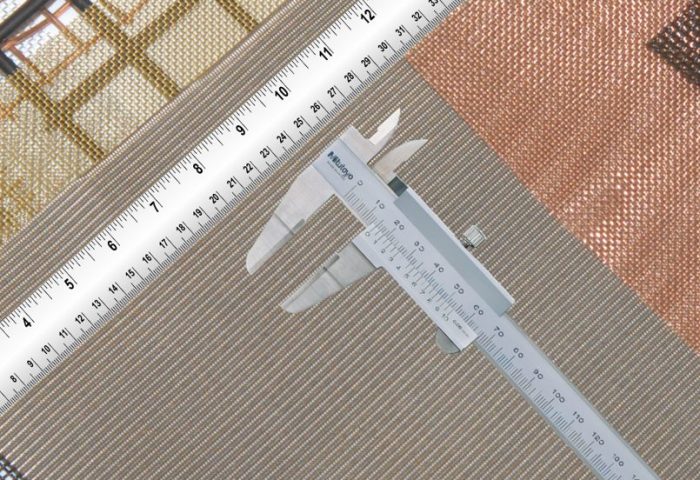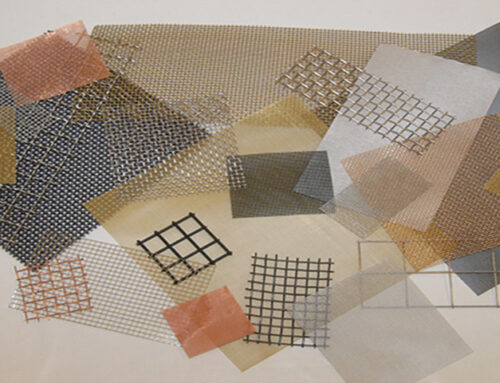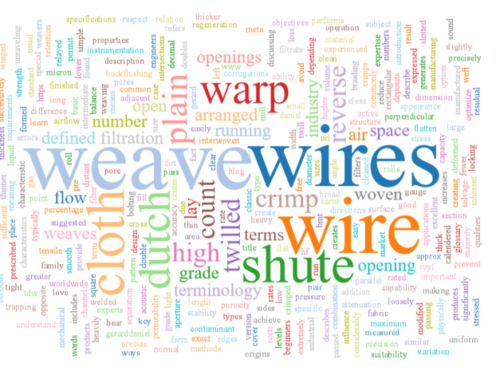Woven and welded wire mesh come in endless sizes and variations. In this article, we will discuss how wire mesh is measured and the factors that go into determining the correct mesh size for different industries and applications.
How is Wire Mesh Measured?
Mesh Count
Mesh count is one of the key parameters when specifying wire mesh. Mesh count describes how many wires are contained in one linear inch. A low mesh count means a low number of wires per inch, a high mesh count equates to many wires per square inch.
When describing the mesh count, a single number such as #25 means that the same number of wires run in each direction, i.e. the wire is a Square or Plain Weave. If the mesh count has two numbers (e.g. 12*95) the mesh is a Dutch Weave and has a different number of wires running in the warp (long) direction than the chute (width) direction. When this occurs, the warp count is always listed first.

Measuring from center to center of wires; 8×8 Count Mesh, 20×20 Count Mesh, and 4×4 Count Mesh
Opening Size
Sometimes mesh is specified by opening size rather than mesh count. The open size of the mesh is the clear opening between adjacent parallel wires, not affected by the diameter of the wire. For Square Mesh, it is calculated using the formula below:

Wherein, D is the Wire Diameter in, and M is the Mesh Count. Additionally, when a mesh is specified by opening size, it is often referred to as Space Cloth.
Open Area %
The open area is the percentage of open space between the wires for air or liquid to flow. It is calculated using the following formula for square weaves:

Wherein, D is the Wire Diameter, and N is the number of wires per linear inch of mesh.
How is Micron Mesh Specified?
Micron mesh is another term for mesh that has a very high mesh count (normally, a Dutch Weave but can also be a Plain Weave). This type of mesh (often referred to as wire cloth or filter cloth) is most often used in filtration applications. The opening space between the wires is very small which leads to it having to be measured in “Micrometers”, (shortened to “Microns”), hence the name.

Many specifications call out a Micron Rating, which is measured differently depending on whether the mesh is Square or Dutch.
Micron Rating
Measured, for Square Mesh, by calculating the open area using the Open Area % formula above. As the open area is a square shape, you can then calculate the micron rating by simply converting the decimal opening into microns. However, because the opening size is not square with a Dutch Weave, the Micron rating for these weaves are instead measured by determining the largest size of particle which is able to pass through the mesh. This is done using laboratory-grade glass beads. It is worth noting that, the Open area for Dutch weaves is also given in %, however, this is generally referred to as ‘Porosity’. Porosity is calculated by measuring the flow rate based on the viscosity of the fluid.
Wire Mesh or Wire Cloth?
In this article, we have referred to ‘Wire Mesh’. Often, however, the question “What’s the difference between Wire Mesh and Wire Cloth?” is asked. The simple answer is that they are inherently the same – wire that is woven in different weaves to form a structure. So, everything in this article referring to Wire Mesh would also apply to Wire Cloth.
Typically, however, the weave is referred to as Mesh when there are larger open spaces between the wires. This is generally used in applications such as cages, infill panels, bug screens, and larger separation challenges. While weave is generally described as Wire Cloth when it is flexible and has a much smaller open area. Wire Cloth is typically used for filtration or fine separation applications.
Choosing the right specification for your application
Remembering, there is no distinct rule for when wire mesh becomes referred to as wire cloth. It is important to know what Mesh Count, opening size, or open area % you need to be able to correctly specify for your application.
While there may be more than one type of specification that will work for a single application. Depending on your requirements, a range of Mesh Counts could work, using different weaves or different wire diameters. However, as the price of raw materials increase, it becomes increasingly critical to lower the total amount of wire used in the weaves, while still providing the correct specification. An application engineer can help make these recommendations.

Varll’s Expertise
At Varll, we’ve been sourcing, weaving, and distributing wire mesh for 38 years and stock a large range of inventory – with over 5000 different types of wire mesh and wire cloth in stock. Our application engineers are available to recommend the most effective, most productive solution to you at your lowest cost of acquisition. We are here to answer any questions you may have.



